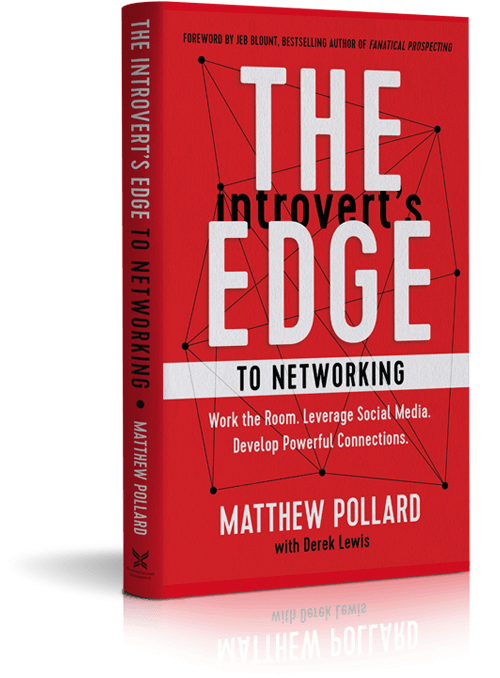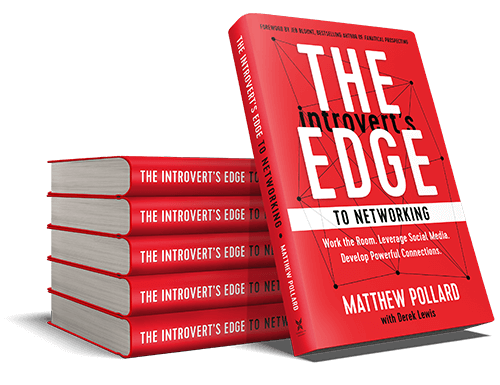Matthew: Hello everyone and welcome back to The Introvert’s Edge Podcast. Today I have an exciting guest for you, he’s a personal friend who actually contributes to the Fortune 100 Best Companies to Work through his organization Great Place to Work. His name is Ed Frauenheim and he’s the Director of Research and Content for Great Place to Work. And also, as a personal compliment, worked with me on an article called Why Austin is the Rockstar of Small Business Cities.
He’s always so focused on making sure that organizations foster a community of inclusiveness across gender, culture, and of course for introverts and extroverts. So with no further ado I’d love to welcome to the show Ed Frauenheim. Ed, thanks so much for joining.
Ed: Matthew, thank you very much for having me.
Matthew: I’m excited about having you on the show because while a lot of people have talked about specific topics about how for themselves handle leading others speaking in public and networking, we haven’t had anybody really talking about how to create and foster a great culture for both introverted and extroverted people. And I know a lot of leaders are like, “Do I need to focus on introverts or do I need to focus on extroverts? How do I do that in a way that best will allow my organization to flourish and grow?” And I think that you’re perfectly placed to talk about that, so I’d love it if you could share some of your wealth of experience with this.
Ed: My pleasure to share what we have to say about that, Matthew. The biggest point we might make about how to be a great place to work for introverts as well as extroverts is really to think about how to create a great place to work for all. And that’s the phrase that really has been guiding us over the last couple years as we’ve kind of updated our methodology and our mission really, to try to ask companies to create a culture that really does work for everybody.
Introverts are among the folks that maybe haven’t historically benefitted as well as extroverts in companies, just as we have found in our data that women haven’t had as good experience as men have, I think minorities haven’t had as good an experience as whites have, and you also can find that leaders of an organization have a much better experience than those lower down in the organization. And we’re really setting a higher bar now overall. When companies are creating their culture they should create a great place to work for all.
Just as a quick adjoiner to that, it’s not just because it’s good to do for the world of introverts or for all the other groups that maybe haven’t had as great an experience, but it’s just good business. We have found the business benefits of having a more consistently great workplace are striking, three times the revenue growth when you can close the gap between the experience of the companies that have the most consistently great experience versus the ones that are least consistently great. It’s a 3x revenue boost. So that’s just one example of why you should be doing this not just for the sake of the people, but for the business as well.
Matthew: Well that’s great because I know that a lot of people listening may be introverts themselves and they want to pass this onto their HR team to listen to about how they can embrace the power of introverts. Not just the skill sets that introverts have, but also to educate them on specific techniques to master what would be considered perhaps more extroverted activities.
From your perspective as a leader, if you’re trying to look at how to aid and empower the introverted community within your organization, what are some of the things you should be thinking about?
Ed: I think one of the first things to be thinking about is leaders should really get to know all their people. We have a new leadership model that we call the “For All Leadership Model”, and what we mean by the top tier of that model – the level 5 leader – is really a “for all” leader. And that means that they are able to have virtually everybody on their team having a great experience. And to do that it really means individualizing the way you lead. It means talking to each person on your team and checking in with them, understanding what their values are, what their visions are, what their characters are, what their personality is, so that you can really bring out the best of the introverts on your team, as well as the extroverts and the ambiverts, so you know what makes them tick and you are responsive to them.
So that’s kind of a high level point, and this style isn’t for just helping out introverts but it helps all these other groups that have historically not had as much authority or not had as good an experience in the organization. Whether that’s women, or those lower down in the organization, or ethnic minorities as well as we’ve talked about
Matthew: What I find though is a lot of leaders are in that situation now where they feel like there’s so many demands on them. They have to be all inclusive, they have to focus on all these different personality types, they have to foster great relationships with so many different diverse groups. And this is just another thing that they’ve got to be mindful of.
If you were in a situation where you were a leader and you were just trying to make the first steps towards being more inclusive within your organization, how would you go about doing that?
Ed: Good question. I think that first part almost can’t be overstated enough, Matthew, the part about listening. Because I think once you listen to your folks, the answer about what’s next is probably going to show up. It may be that you’re going to hear that one of your people would like to have a little more space physically in the office that is a little more solitary, maybe the open floor plan doesn’t work for them and they’re calling for use of a space in a conference room that’s not used much.
Or maybe there is someone else who is saying the way that we’re having these meeting just isn’t working for me because I have some ideas but three other people are always the ones that talk the whole time. And so then maybe you start adjusting your meeting techniques such that maybe you spend some time writing, everyone gets a minute or two to write their ideas down at the beginning and then you maybe share them or whoever wants to share can share.
The next step is not as clear to me but the first step is quite clear. Which is to say, understand what makes people tick. Make that personal connection to really understand who your people are and what’s going to help them thrive.
Matthew: So if I’m understanding this correctly, really what we’re trying to be doing is having conversations to really understand at a deeper level who our staff are, but then actively listening to the answers and then looking for solutions to be able to create a happier workplace – or a happier workplace environment – for everybody that’s concerned.
Ed: Well put. Good active listening on your part, Matthew.
Matthew: Great. Well what I’m actually interested in – because I know you’ve got a huge amount of research that this is based on – so this isn’t just you’ve got some great ideas. Great Place to Work really focuses on backing all that they say up by research, and they’ve got what they call the “5 levels of leadership”.
I would love for you to put that through the lens of the leader looking at their introverted staff and tell me the real value in both understanding the model but also applying it in the day to day workplace.
Ed: Sure. Well this model is something that we just came up with in the last year or so and it came out of a study of 75,000 employees and 10,000 leaders at companies that we have certified as great workplaces. So they already are companies that are doing a pretty good job, but within those companies there’s uneven levels of leadership. And what we did when we studied the data points of employee surveys reflected about particular leaders, we learned that you can really break them down into what we call 5 levels.
The top level is the “For All Leader”, where more than 90% of the people are having a great experience. The next one we call “The Good Leader”, and you’re having more like 80% of the people having a great experience. And it kind of boils down, level 3 is about 60%, level 2 is about 50%, and level 1 is about only 30%. As you move up these levels when you’re an employee on a team of a leader of these different levels, the team performance just improves dramatically. To kind of again give the business case for this, Matthew. But if you go from level 1 to level 5 leadership, the productivity of your team jumps about 350%. It’s just dramatically higher when people are all feeling great about the workplace, they give their all.
Matthew: That’s huge.
Ed: Or they’re much more inclined to be innovative. They’re giving their ideas, they’re sharing ideas, they’re helping the company out with a better process or a better product. That goes up about 325%, the indicator for innovation as well. So this is some of what the research is saying.
Again, it kind of comes down to how those individual leaders reach out and connect with their people. For example, one of the distinctions between the level 4 leader and the level 5 leader that is interesting is that a level 4 leader is almost like a heroic persona. They try to take on the weight of the world and they protect their other people, but they aren’t necessarily connecting their people to those in other parts of the organization.
And if you put it through the lens of an introvert for example, this leader might be the kind of person that is going to broker a conversation with the department that’s in the midst of a joint project. They’ll handle all the communication there and they aren’t going to really empower their own folks to do that work and sort of make that new connection to expand their professional network.
The level 5 leader on the other hand, is much more about getting out of the way, fostering connections and then almost like a servant leader – which is another term that’s out there that I think has got a lot in common with the level 5 leader – you serve your people to help them make those connections. So you’re not the hero, rather you’re kind of helping your people become those heroes.
Matthew: That’s really interesting. It’s so funny to hear such small differences in leadership styles can make such an impact to ROI, productivity, and innovation scores.
Ed: Yeah, it is interesting to dig into the data – which can be complicated – but it does kind of boil down to when people feel great at work they do great things. It’s sort of this simple concept that’s at the core of our work. When everybody is pulling in the same direction and feeling like they’re part of a great culture where they can trust their leaders and they enjoy their colleagues and they take pride in what they do, that’s kind of our root model or a great workplace. When that’s consistently true across the range of introverts and extroverts, men and women, etc, these organizations just take off.
And I can give a quick example of one organization I‘ve just done a deep study on, I can share a little about a study we did on Hilton that has some of these principals.
Matthew: Yeah, I’d love that.
Ed: Well Hilton’s culture – because Hilton wasn’t specific to the extrovert question but I think it speaks to it – we look at how they have done a great job of closing the gap between leaders and front line employees. And the numbers show it. Over the last 5 years they’ve dramatically increased the score, the overall workplace scores on our survey for individual contributors up to the level of most managers. A key part of how they do it is what I was mentioning before, that the individual leaders are speaking to their teammates and seeing themselves as teammates and working alongside them, getting to know them.
I talked to one Hilton catering manager in Chicago and we talked about how she joined a team after it had been lead by someone else after about 17 years and she just kept having these one on one meetings to understand what makes the 20 people or so on her team tick, and she came away with very different answers. Sometimes people love coming up with new ideas for food for the organization and for clients, other people might be in a very different place and their main focus is work/life balance because they’ve got a new baby at home.
So that’s the kind of way I think ultimately you get people to buy into the mission of the organization when they feel known. And I think that is a lesson that can really apply to managing introverts well, to bring the best of them to the table.
Matthew: Well I think that’s a really interesting message for introverts themselves as well who are leaders, because so many introverts like the idea of creating a business because they then can run the business in the privacy of their own home or so they can develop a business that runs around them, their family, and their life, and not the other way around. But then they have to at some stage employ staff. And if you’re not constantly communicating with your staff and understanding what their motivators are and what’s important to them, then you’re always going to have staff that – by the sounds of this research – that are delivering some poor results. ANd also some ideas that they provide or put on the table are going to be a lot less.
We had Ryan Deiss on the podcast a while back and he was talking about the fact that he always used to meet with his team and always had meetings individually to build, and a quality team to then step forward. And now these companies are a lot larger and he just works with the leadership team that then works with those staff members. But it all starts from developing that core team that will just do anything for you. And it sounds like the proof is in the ROI that it seems even in these top organizations that deliver.
Ed: I think that is exactly right, especially if you’re at the top of an organization, you want to get your team having that great experience. We’ve actually honed in on that with a new category as far as measuring the 100 Best Workplaces as executive effectiveness. Does that top team work well together and are they able to cascade that good experience down through the organization in a typical hierarchical organization. So I think that’s right.
But I would say I think there are some ways that introverted leaders can do the work that I’m describing that may not be as uncomfortable or that may be more their speed. I think one thing that’s underutilized in organizations – and probably by some introverted leaders – is getting people to write ideas before they come to meeting, or instead of meetings. I think when you go to meetings and when you ask people to break into small groups or pairs of two where it’s not as difficult for someone that has to speak in front of the whole group, for them to share an idea in a pair is a lot easier.
So I think that if introverted leaders can do things where they might not have to be in front of a whole group necessarily, but they are gathering the viewpoints of the whole group. Whether it is through asynchronous responses where they ask for feedback in writing or even video chat responses. There’s different means of doing this but I think that we too often have this one way of meeting and talking which is a big group setting. That’s where often the loudest voices are most comfortable, and then we miss out on the introverted perspective and it may not serve introverted leaders to do that.
Matthew: I think that’s really great advice because you’re right. When you you say you need to meet with your staff, the automatic vision here is that I’ve got to sit down with all of my staff or I’ve got to meet with every one of my staff members individually. What you’re really highlighting here is that I don’t have to physically be in the same room. I could send a questionnaire, I could ask them a question of what the most important thing to you is right now.
One of the great clients that I worked with in the past – and he sold his company for I think it was $50 million only after a few years – and what he did is he got all of the people to post what their primary goal was in their personal life up on the cork board on the walk to the bathroom. And the reason for that is so he could walk past it everyday and see what was important to them and understand it, and he would write on the occasional one a little note about how he hopes they can get it all or whatever, just to show that he was reading these and paying attention to them. And he said that that created such comraderie because he felt that he was part of their goals and part of their destiny that they’re trying to achieve. And as an introvert himself, that allowed him to feel a lot more comfortable because he could walk up to somebody and just have a conversation with them about that as opposed to trying to figure out what to say.
Ed: Yep, that’s great. And again this is not just something that is a feel good measure for introverts. The research I’ve seen on effective innovation indicates that people are much more effective in coming up with positive, productive, valuable ideas when they first work individually and then come together. And often I think we have this notion of team brainstorming that is suboptimal. So the kind of practices that you’re describing with the cork board or that I’m talking about aren’t just for helping introverts, it’s actually for helping the organization.
Matthew: I think that’s really valuable information because a lot of people that are listening might be going, “Oh, but I can’t go an convince HR to change the entire practices within the business just to help introverts.” These will work as a whole, and the one thing that I think leaders out there listening should know, is that not one leadership style works with all people and it doesn’t work with all people all of the time. So this is one change of practice that we can do some of the time that will help perhaps more introverted people, also help people come to a meeting with a little bit more direction. And then other times, sure there are times for creative thinking in the room. It’s a diverse set of meeting skills that make leaders great.
Ed: Yeah.
Matthew: Now you spent a lot of time on a new book that’s coming out shortly called, A Great Place to Work For All, and I know this is backed by a huge amount of research and there’s some real practical strategies in it for people that are trying to create an all inclusive workplace. I’d love for you to just really share with me a little about why this book came about, why I care about this book, and what it can do for me.
Ed: Sure. The quick story on why it came about – and it’s going to be coming out on March 13th on Amazon, and also we’re giving it away to everyone who comes to our conference, our summit, on March 7-9 in San Francisco – but the reason why we wrote it is that we really wanted to show that we have updated our thinking and our methodology as we’ve talked about earlier. That we’re not just talking about a great place to work on average when we take everybody’s scores on our employee survey for how good a culture is, but rather, is it consistently great. Is it great for all. And we highlight all the evidence that when you are consistently great for everybody in the organization, the business moves ahead.
And I think the answer to your question about why might I care, besides the business case we talked about, two other things we really talked about is that when these companies are great places to work for all, they’re not only great for people they’re better for the world. And with the better for people piece, we’ve got a chapter where we site a lot of research that is about how the workplace ripples out to the rest of our lives as individuals. It’s a big part of how we feel, our well being really, and our health. When we can be in a great place to work we are in a flow, we’re feeling like our talents and human potential is being fully realized. So that’s a big part.
And then it makes the ripples even beyond our own personal well being to our families, to our community, to the world. Insofar as when you have these great places to work for all, not only are they kind of creating greater healthier communities, better families where there’s less parents bringing the difficulties of work into their homelife and having a more conflict-free family life, really these companies are building up the trust level in society.
And again, right at a time when our society is polarizing on political terms and religious terms potentially, these organizations have increased the level of a collaboration and care and camaraderie across the country and across the world in a quiet way. So they’re really a positive force right now and I hope that readers will see that this is another reason why we should all be working toward great places to work for all.
Matthew: I appreciate you sharing that and having looked at the book myself I know it provides a huge amount of value. I do have one follow up question just based on the companies that you’ve spoken to, because as a conference leader myself – and I know you’re very involved the same way – quite frequently I’m approached by making sure that I have the right balance of genders and right cultural balance within the speakers that speak from my stage. And when I have a podcast interview if I don’t have enough gender and cultural diversity I start to get comments.
What I’m surprised is that generally the introversion versus extroversion is generally one of those things not discussed. And the reason why I bring that up is from a great place to work perspective, do you feel that the introversion/extroversion conversation happens at a leadership level around inclusiveness as much as perhaps gender and cultural diversity does?
Ed: No. How about that for a quick answer. I think it’s a missing part of the conversation. I think that’s the great thing about your work and your new book that I was happy to read and endorse. I think you’re really helping to fill a gap. And again, it’s not just a gap that’s nice to have to make introverts feel better, it’s really for the entire society, for organizations in the society to advance. They’ve got to bring everybody along. And for too long we’ve had an extroverted focused society.
As a parent of two kids – one of them I think is pretty introverted – this is an important issue to me, to you, and to a lot of other people as well. And I hope that the work you’re doing is going to raise this conversation up to a higher level.
Matthew: I really appreciate your advice and all the support. You gave an amazing review for my book which I really do appreciate. And I’m sure your book will do amazingly, I know that the whole team at A Great Place To Work has worked incredibly hard on it so I’m really excited to see that out in the world in the hands of people that can actually make a difference in the workplace as a whole.
Ed: Great, well it’s our pleasure to keep plugging along there, Matthew.
Matthew: Well great stuff. And I know that I’ve managed to get you in before your big conference is coming up in San Francisco in the 7-9 of March, so I won’t take you any longer, but I really do appreciate you sharing so much value with the listeners of The Introvert’s Edge.
Ed: My pleasure to be here.
Matthew: Perfect. Well for everyone that’s listening at home today or perhaps on their drive to work or home from work, thank you so much for listening again today. If you enjoyed the content today I urge you to go to iTunes or Google Play or any of the other platforms that allow you to listen to this podcast and make sure you click ‘subscribe’ and post your review. Your reviews and subscriptions really do help to raise us to the top of those charts and allow more introverts perhaps looking for content on how to be successful in both business, their careers, and their lives access this content and start to really change direction in where they’re really heading. So I really appreciate everybody listening today and I look forward to seeing you in the next episode of The Introvert’s Edge. Cheers.


























